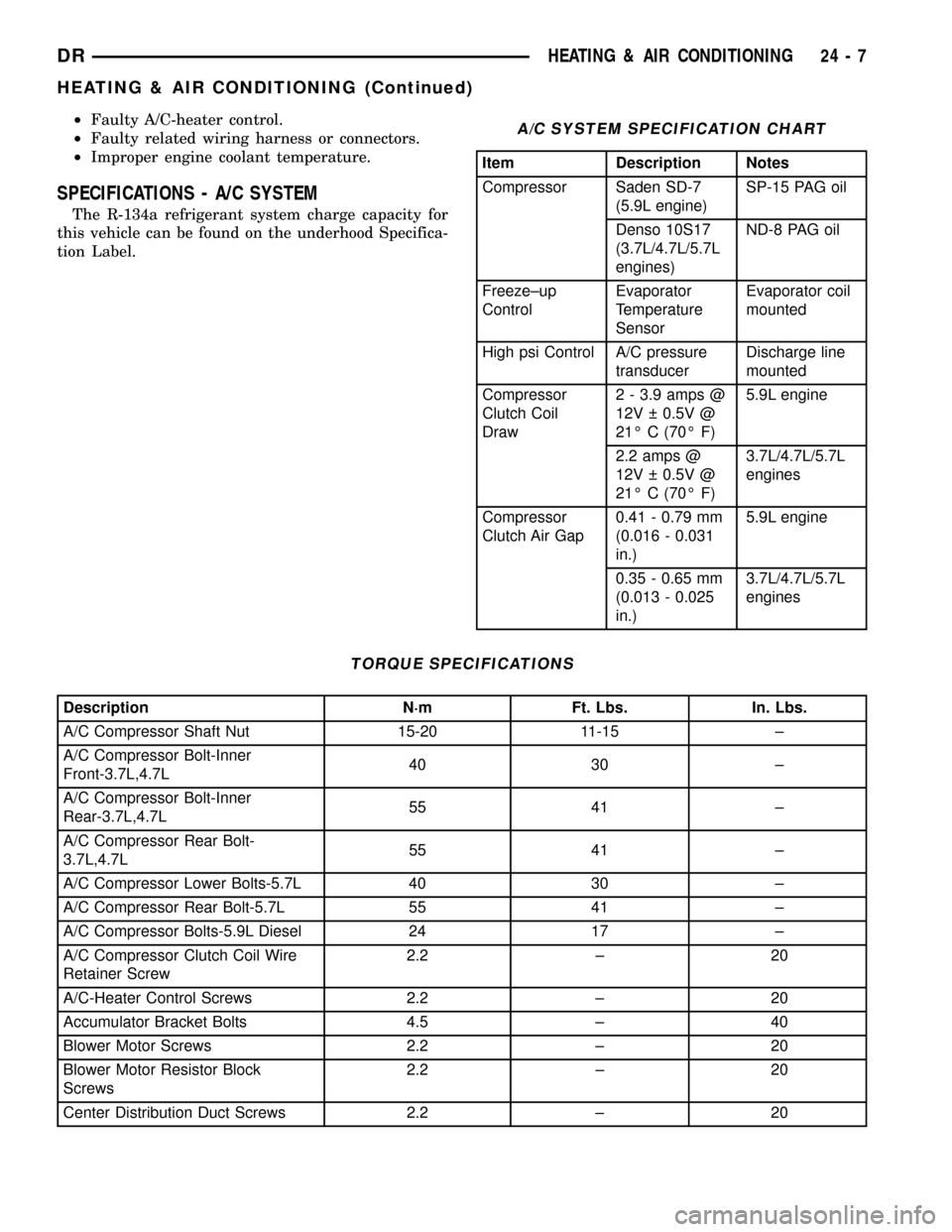1998 DODGE RAM 1500 Engine torque spec
[x] Cancel search: Engine torque specPage 2494 of 2627

²Faulty A/C-heater control.
²Faulty related wiring harness or connectors.
²Improper engine coolant temperature.
SPECIFICATIONS - A/C SYSTEM
The R-134a refrigerant system charge capacity for
this vehicle can be found on the underhood Specifica-
tion Label.
A/C SYSTEM SPECIFICATION CHART
Item Description Notes
Compressor Saden SD-7
(5.9L engine)SP-15 PAG oil
Denso 10S17
(3.7L/4.7L/5.7L
engines)ND-8 PAG oil
Freeze±up
ControlEvaporator
Temperature
SensorEvaporator coil
mounted
High psi Control A/C pressure
transducerDischarge line
mounted
Compressor
Clutch Coil
Draw2 - 3.9 amps @
12V 0.5V @
21É C (70É F)5.9L engine
2.2 amps @
12V 0.5V @
21É C (70É F)3.7L/4.7L/5.7L
engines
Compressor
Clutch Air Gap0.41 - 0.79 mm
(0.016 - 0.031
in.)5.9L engine
0.35 - 0.65 mm
(0.013 - 0.025
in.)3.7L/4.7L/5.7L
engines
TORQUE SPECIFICATIONS
Description N´m Ft. Lbs. In. Lbs.
A/C Compressor Shaft Nut 15-20 11-15 ±
A/C Compressor Bolt-Inner
Front-3.7L,4.7L40 30 ±
A/C Compressor Bolt-Inner
Rear-3.7L,4.7L55 41 ±
A/C Compressor Rear Bolt-
3.7L,4.7L55 41 ±
A/C Compressor Lower Bolts-5.7L 40 30 ±
A/C Compressor Rear Bolt-5.7L 55 41 ±
A/C Compressor Bolts-5.9L Diesel 24 17 ±
A/C Compressor Clutch Coil Wire
Retainer Screw2.2 ± 20
A/C-Heater Control Screws 2.2 ± 20
Accumulator Bracket Bolts 4.5 ± 40
Blower Motor Screws 2.2 ± 20
Blower Motor Resistor Block
Screws2.2 ± 20
Center Distribution Duct Screws 2.2 ± 20
DRHEATING & AIR CONDITIONING 24 - 7
HEATING & AIR CONDITIONING (Continued)
Page 2497 of 2627

and coil are the only serviced parts on the compres-
sor.
A/C compressor clutch engagement is controlled by
several components: the A/C-heater control, A/C pres-
sure transducer, A/C compressor clutch relay, evapo-
rator temperature sensor and the powertrain control
module (PCM). The PCM may delay compressor
clutch engagement for up to thirty seconds (Refer to
8 - ELECTRICAL/ELECTRONIC CONTROL MOD-
ULES/POWERTRAIN CONTROL MODULE -
DESCRIPTION).
DIAGNOSIS AND TESTING - A/C COMPRESSOR
CLUTCH COIL
For circuit descriptions and diagrams, (Refer to
Appropriate Wiring Information). The battery must
be fully-charged before performing the following
tests. Refer to Battery for more information.
(1) Connect an ammeter (0 to 10 ampere scale) in
series with the clutch coil terminal. Use a voltmeter
(0 to 20 volt scale) with clip-type leads for measuring
the voltage across the battery and the compressor
clutch coil.
(2) With the A/C-heater controls in any A/C mode,
and the blower motor switch in the lowest speed
position, start the engine and run it at normal idle.
(3) The compressor clutch coil voltage should read
within 0.2 volts of the battery voltage. If there is
voltage at the clutch coil, but the reading is not
within 0.2 volts of the battery voltage, test the clutch
coil feed circuit for excessive voltage drop and repair
as required. If there is no voltage reading at the
clutch coil, use a DRB IIItscan tool and (Refer to
Appropriate Diagnostic Information) for testing of thecompressor clutch circuit and PCM control. The fol-
lowing components must be checked and repaired as
required before you can complete testing of the clutch
coil:
²Fuses in the junction block and the power distri-
bution center (PDC)
²A/C-heater control
²A/C compressor clutch relay
²A/C pressure transducer
²Evaporator temperature sensor
²Powertrain control module (PCM)
(4) The compressor clutch coil is acceptable if the
current draw measured at the clutch coil is within
specifications with the electrical system voltage at
11.5 to 12.5 volts (Refer to 24 - HEATING & AIR
CONDITIONING - SPECIFICATIONS). This should
only be checked with the work area temperature at
21É C (70É F). If system voltage is more than 12.5
volts, add electrical loads by turning on electrical
accessories until the system voltage drops below 12.5
volts.
(a) If the clutch coil current reading is above
specifications, the coil is shorted and should be
replaced.
(b) If the clutch coil current reading is zero, the
coil is open and should be replaced.
STANDARD PROCEDURE - A/C COMPRESSOR
CLUTCH BREAK-IN
After a new compressor clutch has been installed,
cycle the compressor clutch approximately twenty
times (five seconds on, then five seconds off). During
this procedure, set the A/C-heater control to the
Recirculation Mode, the blower motor switch in the
highest speed position, and the engine speed at 1500
to 2000 rpm. This procedure (burnishing) will seat
the opposing friction surfaces and provide a higher
compressor clutch torque capability.
REMOVAL
The refrigerant system can remain fully-charged
during compressor clutch, rotor, or coil replacement.
The compressor clutch can be serviced in the vehicle.
(1) Disconnect and isolate the battery negative
cable.
(2) Remove the serpentine drive belt (Refer to 7 -
COOLING/ACCESSORY DRIVE/DRIVE BELTS -
REMOVAL).
(3) Disconnect the compressor clutch coil wire har-
ness connector.
(4) Remove the bolts that secure the compressor to
the mounting bracket.
(5) Remove the compressor from the mounting
bracket. Support the compressor in the engine com-
partment while servicing the clutch.
Fig. 1 Compressor Clutch - Typical
1 - CLUTCH PLATE
2 - SHAFT KEY (not used on KJ)
3 - ROTOR
4 - COIL
5 - CLUTCH SHIMS
6 - SNAP RING
7 - SNAP RING
24 - 10 CONTROLSDR
A/C COMPRESSOR CLUTCH/COIL (Continued)
Page 2564 of 2627

Immediately after a cold start, between predeter-
mined temperature thresholds limits, the three port
solenoid is briefly energized. This initializes the
pump by drawing air into the pump cavity and also
closes the vent seal. During non test conditions the
vent seal is held open by the pump diaphragm
assembly which pushes it open at the full travel posi-
tion. The vent seal will remain closed while the
pump is cycling due to the reed switch triggering of
the three port solenoid that prevents the diaphragm
assembly from reaching full travel. After the brief
initialization period, the solenoid is de-energized
allowing atmospheric pressure to enter the pump
cavity, thus permitting the spring to drive the dia-
phragm which forces air out of the pump cavity and
into the vent system. When the solenoid is energized
and de energized, the cycle is repeated creating flow
in typical diaphragm pump fashion. The pump is con-
trolled in 2 modes:
Pump Mode: The pump is cycled at a fixed rate to
achieve a rapid pressure build in order to shorten the
overall test length.
Test Mode: The solenoid is energized with a fixed
duration pulse. Subsequent fixed pulses occur when
the diaphragm reaches the Switch closure point.
The spring in the pump is set so that the system
will achieve an equalized pressure of about 7.5º H20.
The cycle rate of pump strokes is quite rapid as the
system begins to pump up to this pressure. As the
pressure increases, the cycle rate starts to drop off. If
there is no leak in the system, the pump would even-
tually stop pumping at the equalized pressure. If
there is a leak, it will continue to pump at a rate rep-
resentative of the flow characteristic of the size of the
leak. From this information we can determine if the
leak is larger than the required detection limit (cur-
rently set at .040º orifice by CARB). If a leak is
revealed during the leak test portion of the test, the
test is terminated at the end of the test mode and no
further system checks will be performed.
After passing the leak detection phase of the test,
system pressure is maintained by turning on the
LDP's solenoid until the purge system is activated.
Purge activation in effect creates a leak. The cycle
rate is again interrogated and when it increases due
to the flow through the purge system, the leak check
portion of the diagnostic is complete.
The canister vent valve will unseal the system
after completion of the test sequence as the pump
diaphragm assembly moves to the full travel position.
Evaporative system functionality will be verified by
using the stricter evap purge flow monitor. At an
appropriate warm idle the LDP will be energized to
seal the canister vent. The purge flow will be clocked
up from some small value in an attempt to see a
shift in the 02 control system. If fuel vapor, indicatedby a shift in the 02 control, is present the test is
passed. If not, it is assumed that the purge system is
not functioning in some respect. The LDP is again
turned off and the test is ended.
MISFIRE MONITOR
Excessive engine misfire results in increased cata-
lyst temperature and causes an increase in HC emis-
sions. Severe misfires could cause catalyst damage.
To prevent catalytic convertor damage, the PCM
monitors engine misfire.
The Powertrain Control Module (PCM) monitors
for misfire during most engine operating conditions
(positive torque) by looking at changes in the crank-
shaft speed. If a misfire occurs the speed of the
crankshaft will vary more than normal.
FUEL SYSTEM MONITOR
To comply with clean air regulations, vehicles are
equipped with catalytic converters. These converters
reduce the emission of hydrocarbons, oxides of nitro-
gen and carbon monoxide. The catalyst works best
when the Air Fuel (A/F) ratio is at or near the opti-
mum of 14.7 to 1.
The PCM is programmed to maintain the optimum
air/fuel ratio of 14.7 to 1. This is done by making
short term corrections in the fuel injector pulse width
based on the O2S sensor output. The programmed
memory acts as a self calibration tool that the engine
controller uses to compensate for variations in engine
specifications, sensor tolerances and engine fatigue
over the life span of the engine. By monitoring the
actual fuel-air ratio with the O2S sensor (short term)
and multiplying that with the program long-term
(adaptive) memory and comparing that to the limit,
it can be determined whether it will pass an emis-
sions test. If a malfunction occurs such that the PCM
cannot maintain the optimum A/F ratio, then the
MIL will be illuminated.
CATALYST MONITOR
To comply with clean air regulations, vehicles are
equipped with catalytic converters. These converters
reduce the emission of hydrocarbons, oxides of nitro-
gen and carbon monoxide.
Normal vehicle miles or engine misfire can cause a
catalyst to decay. This can increase vehicle emissions
and deteriorate engine performance, driveability and
fuel economy.
The catalyst monitor uses dual oxygen sensors
(O2S's) to monitor the efficiency of the converter. The
dual O2S's sensor strategy is based on the fact that
as a catalyst deteriorates, its oxygen storage capacity
and its efficiency are both reduced. By monitoring
the oxygen storage capacity of a catalyst, its effi-
ciency can be indirectly calculated. The upstream
DREMISSIONS CONTROL 25 - 3
EMISSIONS CONTROL (Continued)
Page 2571 of 2627

EVAPORATIVE EMISSIONS
TABLE OF CONTENTS
page page
EVAPORATIVE EMISSIONS
DESCRIPTION - EVAP SYSTEM............10
SPECIFICATIONS
TORQUE - EVAP SYSTEM...............11
CCV HOSE
DESCRIPTION - 8.0L V-10................12
OPERATION - 8.0L V-10..................12
EVAP/PURGE SOLENOID
DESCRIPTION.........................12
OPERATION...........................12
REMOVAL.............................12
INSTALLATION.........................12
FUEL FILLER CAP
DESCRIPTION.........................13
OPERATION...........................13
REMOVAL
REMOVAL/INSTALLATION...............13
LEAK DETECTION PUMP
DESCRIPTION.........................13
OPERATION...........................14
REMOVAL.............................16
INSTALLATION.........................16ORVR
DESCRIPTION.........................17
OPERATION...........................17
P C V VA LV E
DESCRIPTION.........................17
OPERATION...........................19
DIAGNOSIS AND TESTING - PCV VALVE -
3.7L V-6/ 4.7L V-8......................20
REMOVAL.............................21
INSTALLATION.........................21
VACUUM LINES
DESCRIPTION.........................22
VAPOR CANISTER
DESCRIPTION.........................22
OPERATION...........................22
REMOVAL.............................22
INSTALLATION.........................22
NATURAL VAC LEAK DETECTION ASSY
DESCRIPTION.........................23
OPERATION...........................23
REMOVAL.............................24
INSTALLATION.........................25
EVAPORATIVE EMISSIONS
DESCRIPTION - EVAP SYSTEM
The evaporation control system prevents the emis-
sion of fuel tank vapors into the atmosphere. When
fuel evaporates in the fuel tank, the vapors pass
through vent hoses or tubes into the two charcoal
filled evaporative canisters. The canisters tempo-
rarily hold the vapors. The Powertrain Control Mod-
ule (PCM) allows intake manifold vacuum to draw
vapors into the combustion chambers during certain
operating conditions.
All gasoline powered engines use a duty cycle
purge system. The PCM controls vapor flow by oper-
ating the duty cycle EVAP purge solenoid. Refer to
Duty Cycle EVAP Canister Purge Solenoid for addi-
tional information.When equipped with certain emissions packages, a
Leak Detection Pump (LDP) will be used as part of
the evaporative system. This pump is used as a part
of OBD II requirements. Refer to Leak Detection
Pump for additional information. Other emissions
packages will use a Natural Vacuum Leak Detection
(NVLD) system in place of the LDP. Refer to NVLD
for additional information.
NOTE: The hoses used in this system are specially
manufactured. If replacement becomes necessary, it
is important to use only fuel resistant hose.
Certain EVAP system components can be found in
(Fig. 1).
25 - 10 EVAPORATIVE EMISSIONSDR
Page 2572 of 2627

SPECIFICATIONS
TORQUE - EVAP SYSTEM
DESCRIPTION N´m Ft. Lbs. In. Lbs.
EVAP Canister Mounting
Nuts11 -95
EVAP Canister Mounting
Bracket-to-Frame Bolts14 10125
Leak Detection Pump
Mounting Bolts11 - 9 5
Leak Detection Pump
Filter Mounting Bolt11 - 9 5
Fig. 1 FUEL DELIVERY COMPONENTS
1 - FUEL TANK 8 - LDP FRESH AIR FILTER
2 - CHECK VALVE 9 - LEAK DETECTION PUMP
3 - LIQUID EXPANSION CHAMBER 10 - EVAP CANISTERS (2)
4 - FUEL FILTER / FUEL PRESSURE REGULATOR 11 - FUEL TANK STRAPS (2)
5 - QUICK-CONNECT FITTING AND FUEL LINE (TO ENGINE) 12 - CHECK VALVE
6 - EVAP LINE CONNECTION 13 - FUEL PUMP MODULE LOCK RING
7 - LEAK DETECTION PUMP FRESH AIR LINE 14 - FUEL PUMP MODULE
DREVAPORATIVE EMISSIONS 25 - 11
EVAPORATIVE EMISSIONS (Continued)
Page 2577 of 2627

PUMPING ACTION
Action : During portions of this test, the PCM uses
the reed switch to monitor diaphragm movement.
The solenoid is only turned on by the PCM after the
reed switch changes from open to closed, indicating
that the diaphragm has moved down. At other times
during the test, the PCM will rapidly cycle the LDP
solenoid on and off to quickly pressurize the system.
During rapid cycling, the diaphragm will not move
enough to change the reed switch state. In the state
of rapid cycling, the PCM will use a fixed time inter-
val to cycle the solenoid. If the system does not pass
the EVAP Leak Detection Test, the following DTCs
may be set:
²P0442 - EVAP LEAK MONITOR 0.0409LEAK
DETECTED
²P0455 - EVAP LEAK MONITOR LARGE LEAK
DETECTED
²P0456 - EVAP LEAK MONITOR 0.0209LEAK
DETECTED
²P1486 - EVAP LEAK MON PINCHED HOSE
FOUND
²P1494 - LEAK DETECTION PUMP SW OR
MECH FAULT
²P1495 - LEAK DETECTION PUMP SOLENOID
CIRCUIT
REMOVAL
The Leak Detection Pump (LDP) and LDP filter
are attached to the front of the EVAP canister
mounting bracket (Fig. 9). This is located near the
front of the fuel tank. The LDP and LDP filter are
replaced (serviced) as one unit.
(1) Raise and support vehicle.
(2) Carefully remove hose at LDP filter.
(3) Remove LDP filter mounting bolt and remove
from vehicle.
(4) Carefully remove vapor/vacuum lines at LDP.
(5) Disconnect electrical connector at LDP.
(6) Remove LDP mounting bolt and remove LDP
from vehicle.
INSTALLATION
The LDP and LDP filter are attached to the front
of the EVAP canister mounting bracket. The LDP
and LDP filter are replaced (serviced) as one unit.
(1) Install LDP to mounting bracket. Refer to
Torque Specifications.
(2) Install LDP filter to mounting bracket. Refer to
Torque Specifications.
(3) Carefully install vapor/vacuum lines to LDP,
and install hose to LDP filter.The vapor/vacuum
lines and hoses must be firmly connected.
Fig. 8 DIAPHRAGM DOWNWARD MOVEMENT
1 - Diaphragm
2 - Inlet Check Valve (Closed)
3 - Vent Valve (Closed)
4 - From Air Filter
5 - To Canister
6 - Outlet Check Valve (Open)
7 - Engine Vacuum (Closed)
Fig. 9 LDP AND LDP FILTER LOCATION
1 - LDP
2 - LDP MOUNTING BOLT
3 - ELEC. CONNEC.
4 - FILTER MOUNTING BOLT
5 - LDP FILTER
6 - CONNECTING HOSE
7 - EVAP CANISTER MOUNTING BRACKET
8 - EVAP CANISTERS (2)
25 - 16 EVAPORATIVE EMISSIONSDR
LEAK DETECTION PUMP (Continued)
Page 2583 of 2627

5.7L V-8
(1) Clean out intake manifold opening.
(2) Check condition of 2 o-rings on PCV valve.
(3) Apply engine oil to 2 o-rings.
(4) Place PCV valve into intake manifold and
rotate 90 degrees clockwise for installation.
VACUUM LINES
DESCRIPTION
A vacuum schematic for emission related items can
be found on the vehicles VECI label. Refer to Vehicle
Emission Control Information (VECI) Label for label
location.
VAPOR CANISTER
DESCRIPTION
Two, maintenance free, EVAP canisters are used.
Both canisters are mounted into a two-piece support
bracket located near the front of the fuel tank (Fig.
23).
OPERATION
Two, maintenance free, EVAP canisters are
used.The EVAP canisters are filled with granules of
an activated carbon mixture. Fuel vapors entering
the EVAP canisters are absorbed by the charcoal
granules.
Fuel tank pressure vents into the EVAP canisters.
Fuel vapors are temporarily held in the canisters
until they can be drawn into the intake manifold.
The duty cycle EVAP canister purge solenoid allows
the EVAP canisters to be purged at predetermined
times and at certain engine operating conditions.
REMOVAL
Two, maintenance free, EVAP canisters are used.
Both canisters are mounted into a two-piece support
bracket located near the front of the fuel tank (Fig.
23).
(1) Raise and support vehicle.
(2) Remove fuel tubes/lines at each EVAP canister.
Note location of tubes/lines before removal for easier
installation.
(3) Remove lower support bracket (Fig. 24).
(4) Remove mounting nuts at top of each canister
(Fig. 24).
(5) Remove each canister from upper support
bracket.
INSTALLATION
(1) Place each canister into upper support bracket
and install nuts. Refer to Torque Specifications.
(2) Install lower support bracket. Refer to Torque
Specifications.
(3) Carefully install vapor/vacuum lines.The
vapor/vacuum lines and hoses must be firmly
connected. Also check the vapor/vacuum lines
at the LDP, LDP filter and EVAP canister purge
solenoid for damage or leaks. If a leak is
present, a Diagnostic Trouble Code (DTC) may
be set.
Fig. 23 LOCATION, EVAP CANISTERS
1 - LDP
2 - LDP MOUNTING BOLT
3 - ELEC. CONNEC.
4 - FILTER MOUNTING BOLT
5 - LDP FILTER
6 - CONNECTING HOSE
7 - EVAP CANISTER MOUNTING BRACKET
8 - EVAP CANISTERS (2)
25 - 22 EVAPORATIVE EMISSIONSDR
PCV VALVE (Continued)
Page 2595 of 2627

CONTROL MODULE - DESCRIPTION,
AIRBAG............................8O-11
CONTROL MODULE - DESCRIPTION,
FRONT...........................8W-97-5
CONTROL MODULE - DESCRIPTION,
FRONT..............................8E-5
CONTROL MODULE - DESCRIPTION,
TRANSFER CASE.....................8E-16
CONTROL MODULE - DESCRIPTION,
TRANSMISSION......................8E-20
CONTROL MODULE - DIAGNOSIS AND
TESTING, FRONT...................8W-97-5
CONTROL MODULE - DIAGNOSIS AND
TESTING, FRONT......................8E-5
CONTROL MODULE - INSTALLATION,
AIRBAG............................8O-13
CONTROL MODULE - INSTALLATION,
ENGINE.............................8E-4
CONTROL MODULE - INSTALLATION,
FRONT...........................8W-97-6
CONTROL MODULE - INSTALLATION,
FRONT..............................8E-5
CONTROL MODULE - OPERATION,
AIRBAG............................8O-11
CONTROL MODULE - OPERATION,
FRONT...........................8W-97-5
CONTROL MODULE - OPERATION,
FRONT..............................8E-5
CONTROL MODULE - OPERATION,
TRANSFER CASE.....................8E-16
CONTROL MODULE - OPERATION,
TRANSMISSION......................8E-20
CONTROL MODULE - REMOVAL, AIRBAG . 8O-12
CONTROL MODULE - REMOVAL, ENGINE . . . 8E-4
CONTROL MODULE - REMOVAL, FRONT . 8W-97-6
CONTROL MODULE - REMOVAL, FRONT . . . 8E-5
CONTROL MOTOR - DESCRIPTION, IDLE
AIR ...............................14-28
CONTROL MOTOR - INSTALLATION, IDLE
AIR ...............................14-29
CONTROL MOTOR - OPERATION, IDLE
AIR ...............................14-28
CONTROL MOTOR - REMOVAL, IDLE AIR . . 14-29
CONTROL RELAY - DESCRIPTION,
TRANSMISSION.....................21-405
CONTROL RELAY - OPERATION,
TRANSMISSION.....................21-405
CONTROL SWITCH - DESCRIPTION,
LUMBAR...........................8N-17
CONTROL SWITCH - OPERATION,
LUMBAR...........................8N-18
CONTROL SWITCH - REMOVAL,
LUMBAR...........................8N-18
CONTROLLED VISCOUS FAN DRIVE -
DIAGNOSIS AND TESTING,
ELECTRONICALLY.....................7-52
CONTROLLER ANTILOCK BRAKE -
DESCRIPTION........................8E-3
CONTROLLER ANTILOCK BRAKE -
INSTALLATION........................8E-3
CONTROLLER ANTILOCK BRAKE -
OPERATION..........................8E-3
CONTROLLER ANTILOCK BRAKE -
REMOVAL...........................8E-3
CONTROLS - DIAGNOSIS AND TESTING,
OVERDRIVE ELECTRICAL.............21-262
CONVERTER - DESCRIPTION, CATALYTIC
. . . 11-6
CONVERTER - DESCRIPTION, TORQUE
. . 21-255,
21-399
CONVERTER - INSTALLATION, TORQUE
. . 21-260,
21-404
CONVERTER - OPERATION, CATALYTIC
....11-6
CONVERTER - OPERATION, TORQUE
....21-259,
21-403
CONVERTER - REMOVAL, TORQUE
.....21-260,
21-404
CONVERTER DRAINBACK VALVE -
DESCRIPTION, TORQUE
..............21-261
CONVERTER DRAINBACK VALVE -
OPERATION, TORQUE
................21-261
CONVERTER DRAINBACK VALVE -
STANDARD PROCEDURE, TORQUE
......21-261
CONVERTER HOUSING FLUID LEAK -
DIAGNOSIS AND TESTING
......21-144,21-318
COOLANT - DESCRIPTION, ENGINE
.......7-31
COOLANT - DESCRIPTION, ENGINE
........0-3
COOLANT - DESCRIPTION, HOAT
.........7-32COOLANT - STANDARD PROCEDURE,
ADDING ADDITIONAL..................7-19
COOLANT FLOW - DIAGNOSIS AND
TESTING, RADIATOR...............7-54,7-56
COOLANT LEVEL CHECK - STANDARD
PROCEDURE.........................7-17
COOLANT RECOVERY CONTAINER- GAS
ENGINES - DESCRIPTION...............7-33
COOLANT RECOVERY CONTAINER- GAS
ENGINES - INSTALLATION...............7-33
COOLANT RECOVERY CONTAINER- GAS
ENGINES - OPERATION.................7-33
COOLANT RECOVERY CONTAINER- GAS
ENGINES - REMOVAL..................7-33
COOLANT TEMPERATURE SENSOR -
DESCRIPTION, ENGINE.................7-38
COOLANT TEMPERATURE SENSOR -
INSTALLATION, ENGINE................7-41
COOLANT TEMPERATURE SENSOR -
OPERATION, ENGINE...................7-38
COOLANT TEMPERATURE SENSOR -
REMOVAL, ENGINE....................7-39
COOLANT THERMOSTAT - 3.7L/4.7L -
DESCRIPTION, ENGINE.................7-44
COOLANT THERMOSTAT - 3.7L/4.7L -
INSTALLATION, ENGINE................7-45
COOLANT THERMOSTAT - 3.7L/4.7L -
OPERATION, ENGINE...................7-44
COOLANT THERMOSTAT - 3.7L/4.7L -
REMOVAL, ENGINE....................7-45
COOLANT THERMOSTAT - 5.9L DIESEL -
DESCRIPTION, ENGINE.................7-46
COOLANT THERMOSTAT - 5.9L DIESEL -
INSTALLATION, ENGINE..................7-47
COOLANT THERMOSTAT - 5.9L DIESEL -
OPERATION, ENGINE...................7-46
COOLANT THERMOSTAT - 5.9L DIESEL -
REMOVAL, ENGINE....................7-47
COOLANT THERMOSTAT - 8.0L -
DESCRIPTION, ENGINE.................7-48
COOLANT THERMOSTAT - 8.0L -
INSTALLATION, ENGINE................7-49
COOLANT THERMOSTAT - 8.0L -
OPERATION, ENGINE...................7-48
COOLANT THERMOSTAT - 8.0L -
REMOVAL, ENGINE....................7-49
COOLANT THERMOSTAT-5.7L -
DESCRIPTION, ENGINE.................7-41
COOLANT THERMOSTAT-5.7L -
INSTALLATION, ENGINE................7-43
COOLANT THERMOSTAT-5.7L -
OPERATION, ENGINE...................7-41
COOLANT THERMOSTAT-5.7L -
REMOVAL, ENGINE....................7-42
COOLER - 5.9L DIESEL - DESCRIPTION,
TRANS..............................7-68
COOLER - 5.9L DIESEL - OPERATION,
TRANS..............................7-69
COOLER - DESCRIPTION, TRANS.........7-67
COOLER - INSTALLATION, AIR TO OIL.....7-70
COOLER - INSTALLATION, FLUID........19-43
COOLER - INSTALLATION, RETURN
HOSE - GEAR TO................19-44,19-45
COOLER - INSTALLATION, RETURN
HOSE - RESERVOIR TO...........19-44,19-45
COOLER - INSTALLATION, TRANS........7-68
COOLER - INSTALLATION, WATER-TO-
AIR
................................7-70
COOLER - OPERATION, TRANS
...........7-67
COOLER - REMOVAL, AIR TO OIL
.........7-69
COOLER - REMOVAL, FLUID
............19-43
COOLER - REMOVAL, RETURN HOSE -
GEAR TO
......................19-44,19-45
COOLER - REMOVAL, RETURN HOSE -
RESERVOIR TO
.................19-44,19-45
COOLER - REMOVAL, TRANS
............7-68
COOLER - REMOVAL, WATER TO OIL
......7-69
COOLER AND PLUMBING - CLEANING,
CHARGE AIR
........................11-17
COOLER AND PLUMBING -
DESCRIPTION, CHARGE AIR
............11-16
COOLER AND PLUMBING - INSPECTION,
CHARGE AIR
........................11-17
COOLER AND PLUMBING -
INSTALLATION, CHARGE AIR
...........11-17
COOLER AND PLUMBING - OPERATION,
CHARGE AIR
........................11-16COOLER AND PLUMBING - REMOVAL,
CHARGE AIR........................11-17
COOLER SYSTEM - LEAKS - DIAGNOSIS
AND TESTING, CHARGE AIR............11-16
COOLING, SPECIAL TOOLS..............7-20
COOLING SYSTEM - ALL GAS ENGINES -
STANDARD PROCEDURE, DRAINING......7-17
COOLING SYSTEM - ALL GAS ENGINES -
STANDARD PROCEDURE, REFILLING......7-18
COOLING SYSTEM - OPERATION..........7-5
COOLING SYSTEM - TESTING FOR
LEAKS - DIAGNOSIS AND TESTING........7-5
COOLING SYSTEM 5.9L DIESEL ENGINE
- STANDARD PROCEDURE, DRAINING.....7-18
COOLING SYSTEM 5.9L DIESEL ENGINE
- STANDARD PROCEDURE, REFILLING.....7-19
COOLING SYSTEM CLEANING/REVERSE
FLUSHING - STANDARD PROCEDURE.....7-17
COOLING SYSTEM DIESEL ENGINE -
DIAGNOSIS AND TESTING...............7-7
COOLING SYSTEM FLOW - 5.9L DIESEL
- DESCRIPTION........................7-3
COOLING SYSTEM FLOW 3.7L/4.7L/5.7L
ENGINE - DESCRIPTION.................7-1
COOLING SYSTEM REQUIREMENTS -
DESCRIPTION, ENGINE.................24-1
COOLING SYSTEM, WARNING - ENGINE . . 24-42
CORE - DESCRIPTION, HEATER.........24-63
CORE - DESCRIPTION, SERVICE PORT
VALVE .............................24-70
CORE - INSTALLATION, HEATER.........24-63
CORE - INSTALLATION, SERVICE PORT
VALVE .............................24-70
CORE - OPERATION, HEATER...........24-63
CORE - REMOVAL, HEATER............24-63
CORE HOLE PLUG - INSTALLATION,
CAMSHAFT.........................9-206
CORE HOLE PLUG - REMOVAL,
CAMSHAFT.........................9-205
CORE PLUGS - INSTALLATION..........9-131
CORE PLUGS - REMOVAL..............9-131
CORES - REMOVAL, SERVICE PORT
VALVE .............................24-70
COUPLER - DESCRIPTION,
REFRIGERANT LINE...................24-67
COUPLER - INSTALLATION,
REFRIGERANT LINE...................24-68
COUPLER - OPERATION, REFRIGERANT
LINE...............................24-67
COUPLER - REMOVAL, REFRIGERANT
LINE...............................24-68
COUPLING - INSTALLATION, UPPER
STEERING..........................19-13
COUPLING - REMOVAL, UPPER
STEERING..........................19-13
COVER - DESCRIPTION, STRUCTURAL . . . 9-145,
9-216,9-57
COVER - FRONT - INSTALLATION, SEAT
BACK CUSHION......................23-82
COVER - FRONT - INSTALLATION, SEAT
CUSHION...........................23-83
COVER - FRONT - REMOVAL, SEAT BACK
CUSHION...........................23-82
COVER - FRONT - REMOVAL, SEAT
CUSHION...........................23-83
COVER - INSTALLATION...............23-16
COVER - INSTALLATION, ACM
..........8O-10
COVER - INSTALLATION, CENTER SEAT
BACK INERTIA HINGE
.................23-77
COVER - INSTALLATION, CENTER SEAT
CUSHION
...........................23-79
COVER - INSTALLATION, CYLINDER
HEAD
..............................9-255
COVER - INSTALLATION, DIFFERENTIAL
....3-97
COVER - INSTALLATION, GEAR HOUSING
. 9-301
COVER - INSTALLATION, INSTRUMENT
PANEL TOP
.........................23-59
COVER - INSTALLATION, REAR DOOR
SILL TRIM
..........................23-71
COVER - INSTALLATION, SHIFT
. . . 21-129,21-87
COVER - INSTALLATION, STEERING
COLUMN OPENING
...................23-60
COVER - INSTALLATION, STRUCTURAL
. . . 9-145,
9-216,9-57
COVER - INSTALLATION, TIMING/CHAIN
. . 9-227
COVER - OPERATION, STRUCTURAL
.....9-145,
9-216,9-57
8 INDEXDR
Description Group-Page Description Group-Page Description Group-Page